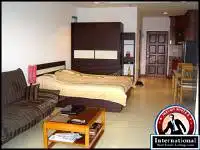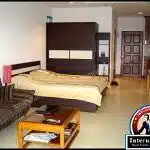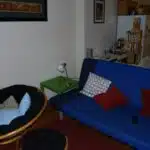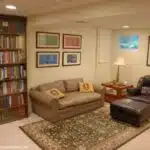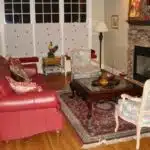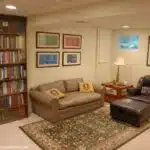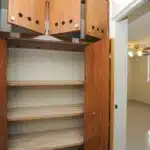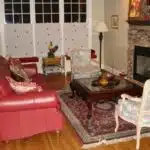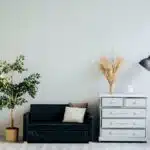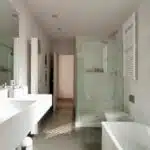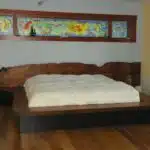Decorating a studio apartment can be both exciting and challenging. With limited space, it can be difficult to know how to create a functional and stylish living space that feels like home. There are many factors to consider when decorating a studio apartment, such as the layout of the space, the amount of natural light, and the overall aesthetic you want to achieve.
As an interior design writer, I have seen firsthand how creative solutions can transform even the smallest of spaces into a comfortable and inviting home. With careful planning and thoughtful design choices, you can make your studio apartment feel spacious and stylish. In this article, we will explore some tips and tricks for decorating a studio apartment that will help you maximize your space while creating a beautiful and functional living area. Whether you are moving into your first apartment or downsizing from a larger home, these tips will help you create a cozy retreat that reflects your personal style.
Assessing Your Space And Needs
Decorating a studio apartment can be likened to a puzzle; you need to find the perfect pieces that fit together to create a cohesive design. Before diving into the process, it’s essential to assess your space and needs. Start by taking measurements of your apartment to determine the amount of available floor space. This information will come in handy when selecting furniture that is both functional and aesthetically pleasing.
When assessing furniture, consider pieces that serve multiple purposes, such as a sofa bed or an ottoman that doubles as storage. A functional layout is crucial in a studio apartment, where every square inch counts. Consider dividing your space into zones such as sleeping, living, and working areas using furniture placement or room dividers. Keep in mind that having too many pieces of furniture can make your small space feel cluttered and overwhelming.
In addition to assessing your physical space, think about your lifestyle needs. If you love hosting dinner parties or having guests over for game night, opt for seating with ample cushions and a sturdy table for entertaining. On the other hand, if you’re someone who values privacy and relaxation, consider creating a cozy reading nook or investing in soundproof curtains for added tranquillity. By taking time to assess both your physical space and lifestyle needs, you’ll be better equipped to create an inviting atmosphere in your studio apartment.
As you begin planning how to decorate your studio apartment, don’t overlook the importance of setting a budget. While it’s tempting to splurge on trendy decor items or high-end furniture pieces, remember that quality doesn’t always equate with price tag. With careful planning and thoughtful consideration of each purchase decision, you can create an affordable yet stylish living space that meets all of your needs. So grab a notebook and pen – it’s time to start brainstorming!
Setting A Budget
After assessing your space and needs, the next step in decorating a studio apartment is to create a budget. This will help you prioritize what items you need to purchase and where you can save money. When it comes to budgeting for a small space, it’s important to be mindful of your spending and make sure you’re getting the most out of each item.
When creating a budget, it’s important to identify areas where you can save money. For example, consider purchasing secondhand furniture or decor from thrift stores or online marketplaces. You can also repurpose items you already own, such as using an old dresser as a TV stand or turning a ladder into a bookshelf. However, there may also be areas where it’s worth splurging on high-quality items that will last longer and add value to the overall design.
Sticking to your budget can be challenging, but there are some tips and tricks that can help. One strategy is to prioritize your spending by identifying which items are most important or necessary for your lifestyle. Another approach is to set specific goals for how much you want to spend on each category of items, such as furniture, lighting, and decor. By being intentional with your spending and sticking to your budget, you’ll create a beautiful and functional studio apartment that fits within your financial means.
To begin establishing a design plan for your studio apartment, start with the basics such as color palette and layout considerations. By having a clear vision in mind before making purchases or starting any projects, you’ll be able to create a cohesive design throughout the space that reflects your personal style and meets your practical needs.
Establishing A Design Plan
Developing a Design Plan is the first step towards transforming a studio apartment into a cozy and functional living space. Creating mood and enhancing comfort are the two key aspects that should be kept in mind while establishing a design plan. A well-thought-out design plan will help you to create an organized, welcoming, and inviting atmosphere.
Creating mood is an essential component of interior design. It involves selecting the right colors, textures, and lighting to evoke specific emotions. For instance, warm colors such as reds, oranges, and yellows create a lively and energetic ambiance. On the other hand, cool colors such as blues and greens promote relaxation and calmness. By choosing appropriate lighting fixtures that complement your color scheme, you can further enhance the mood of your studio apartment.
Enhancing comfort is another crucial aspect of designing your studio apartment. When it comes to small spaces like studios, maximizing comfort is critical since it directly affects how much time you spend in your home. Comfortable furniture such as plush sofas or armchairs with soft cushions can make all the difference when it comes to relaxation. Soft rugs or floor cushions can also add warmth without taking up too much space. By prioritizing comfort in your design plan, you can ensure that your studio apartment feels like home from day one.
Transition: Now that we have established the importance of developing a design plan for your studio apartment let’s move on to choosing a color scheme that complements your style and personality.
Choosing A Color Scheme
When it comes to decorating a studio apartment, choosing the right color scheme can make all the difference. Color psychology is important to consider as different colors can evoke different emotions and moods. For instance, blue is often associated with calmness and relaxation while red is known for its energy and passion. Hence, it is important to select colors that will help create the desired atmosphere in your living space.
In addition to considering color psychology, it is also important to incorporate accent colors into your chosen color scheme. Accent colors are used to add a pop of color or interest to a room, and can be achieved through accessories like throw pillows, rugs or artwork. The key here is not to overdo it – stick to one or two accent colors at most so that they complement rather than clash with the main color scheme.
Ultimately, the goal of selecting a color scheme for your studio apartment should be to create an environment that feels comfortable and inviting. By taking into account color psychology and incorporating accent colors in moderation, you can achieve just that.
As you move forward with your decorating plans, keep in mind that maximizing natural light can also play a key role in creating an inviting living space. With this in mind, let’s explore some tips on how you can optimize natural light in your studio apartment.
Maximizing Natural Light
To further enhance the overall ambiance of your studio apartment, it is essential to capitalize on natural light sources. Not only does natural light create a welcoming atmosphere, but it also has a positive effect on our mood and health. The first step in maximizing natural light is to ensure that your windows are clean and unobstructed. This will allow maximum sunlight to enter your space, making it feel brighter and more spacious.
Another way to maximize natural light is by selecting appropriate window treatments. Opting for sheer curtains or blinds instead of heavy drapes will allow more light to filter through while still maintaining privacy. If you prefer a darker room for sleeping or working, consider adding blackout shades or curtains that can easily be opened when natural light is desired.
In addition to maximizing natural light, selecting furniture that complements your studio apartment’s overall aesthetic is crucial. When choosing furniture pieces, consider functionality and scale to ensure they fit comfortably within the space without overpowering it. Incorporating multi-functional furniture such as a sofa bed or storage ottoman can help save space while still providing comfort and convenience.
As you continue decorating your studio apartment, keep in mind the importance of utilizing natural light sources through proper window treatments and maximizing its effects on mood and health. Additionally, carefully selecting furniture pieces that complement the overall aesthetic of your space while remaining functional will help create a cohesive and comfortable living environment.
Selecting Furniture
Did you know that the average studio apartment in the United States is only 500 square feet? This means that space optimization is crucial when selecting furniture for your studio apartment. It is important to choose furniture that serves multiple purposes and maximizes the limited space available.
When selecting furniture for your studio apartment, it’s also important to consider your style preferences. Do you prefer a minimalist look or something more eclectic? The good news is that there are plenty of furniture options available that can fit any style preference while still being functional and space-saving. From sleek, modern pieces to vintage finds, there’s no shortage of options to choose from.
To make the most out of your small living space, consider opting for multi-functional pieces such as a sofa bed or a coffee table with hidden storage compartments. When it comes to decorating a studio apartment, incorporating storage solutions is key. By using both vertical and horizontal storage options, you can free up valuable floor space and keep clutter at bay. In the next section, we will dive deeper into how you can incorporate storage solutions into your small living space without sacrificing style or functionality.
Incorporating Storage Solutions
In a studio apartment, maximizing storage space is crucial. However, it can be challenging to find the right balance between functionality and aesthetics. Luckily, there are many creative storage solutions available that don’t sacrifice style for practicality.
One way to incorporate storage into your studio apartment is by utilizing DIY organization projects. For example, you can create a vertical shelving system using wall-mounted brackets and wooden boards. This not only adds storage but also serves as a decorative element in the room. Another option is to repurpose everyday items like baskets or crates to store items such as blankets or magazines.
Another great option for adding storage in a studio apartment is by investing in furniture with built-in storage. For instance, choose a bed frame with drawers underneath or an ottoman that doubles as both extra seating and hidden storage. These pieces add functionality without taking up additional floor space.
Overall, incorporating creative storage solutions is essential when decorating a studio apartment. By thinking outside the box and utilizing DIY projects along with multi-functional furniture pieces, you can maximize your space while still maintaining your personal style.
Transition: Now that we’ve covered how to incorporate creative storage solutions into your studio apartment let’s move on to creating zones within your space.
Creating Zones Within Your Space
Incorporating storage solutions into a studio apartment is a crucial first step in creating a functional and clutter-free space. However, it’s equally important to create designated areas within your living space. This can be achieved by using multifunctional furniture and decor to define specific areas for different activities.
Creating designated areas within a studio apartment is all about maximizing the limited space you have. One effective way to do this is by using multifunctional furniture that serves more than one purpose. For example, a sofa bed can be used for both seating and sleeping, while a coffee table with hidden storage can serve as both a surface for entertaining guests and a place to store extra pillows and blankets.
Another way to create designated areas within your living space is by using small decor items to visually separate different zones. You could use area rugs or curtains to divide your bedroom from your living room, or use bookshelves or screens to create privacy when needed. By defining specific areas for different activities, you’ll make your studio apartment feel more welcoming and functional.
Using mirrors to create the illusion of space is another great way to maximize the limited square footage of a studio apartment. Mirrors can reflect light and make your space feel brighter and larger than it actually is. You could hang a large mirror on one wall or add smaller mirrors throughout your living space to create an open and airy feel. By incorporating these design tips into your studio apartment, you’ll be able to create a functional, stylish, and inviting home that maximizes every inch of available space.
Using Mirrors To Create Illusion Of Space
Mirrors are a great way to create the illusion of space in a studio apartment. They reflect light and can make any room appear larger than it actually is. One of the most effective mirror placement tips is to place them opposite windows or other sources of natural light. This will not only make the room appear brighter, but also give the impression of an additional window.
Another way to incorporate mirrors into studio apartment décor is through DIY mirror projects. Besides being cost-effective, these projects allow for customization and personalization of the mirror design. For example, one can create a mirrored accent wall by attaching small mirrors to a panel or using adhesive decals to create a patterned effect. Alternatively, one can repurpose old picture frames by adding mirrors and creating a unique decorative element.
When placing mirrors in a studio apartment, it is important to consider that they can also reflect clutter and create an overwhelming visual effect. As such, it is recommended to use mirrors sparingly and strategically. Additionally, one should avoid placing them at eye level as this may result in awkward reflections. Instead, try incorporating them into furniture pieces such as wardrobe doors or as part of shelving units.
Incorporating mirrors into studio apartment décor not only creates the illusion of space but also adds depth and dimensionality to the living space. However, it is important to approach their placement with intentionality and consideration for their potential impact on the overall aesthetic. Once strategically placed, adding personal touches such as artwork or plants can further enhance the visual appeal of the space without overpowering its reflective elements.
Adding Personal Touches
- Introducing color in a studio apartment can be done in a number of ways, from painting the walls to adding colorful furniture and accessories.
- Artwork can be used to bring personality to the room, whether it is a gallery wall of prints or a single statement piece.
- Accessories such as rugs, throw pillows, and curtains are all easy ways to bring in texture and color that can be switched up to refresh the room.
- To make a small space feel larger, it is important to use light colors and hang curtains high to make the ceilings seem taller.
- To make a studio apartment feel cozy, consider adding a gallery wall of photos and artwork, or an area rug to define the space.
- Accessories should be chosen based on the desired style, from vintage pieces to modern statement pieces.
Bringing In Color
When it comes to decorating a studio apartment, adding personal touches is essential to make the space feel like home. One of the easiest ways to do this is by bringing in color. Color psychology plays a significant role in interior design and can impact mood and emotions. Choosing colors that resonate with your personality can create a sense of harmony and balance within the space.
DIY color accents are an excellent way to add pops of color without breaking the bank. Consider painting an accent wall or adding colorful throw pillows and blankets to your furniture. You could also hang vibrant artwork or create a gallery wall using photos or prints that feature your favorite hues. Another DIY option is to use washi tape or removable wallpaper to add colorful patterns and designs to your walls.
When it comes to incorporating color, don’t forget about natural elements such as plants and flowers. Not only do they bring life into the space, but they also provide natural pops of color. Consider adding succulents, air plants, or fresh flowers in colorful vases throughout your studio apartment for an easy and inexpensive way to add some personality and style. With these simple tips, you can easily bring in color and create a personalized space that feels like home.
Adding Artwork
Adding artwork is another great way to personalize your studio apartment and create a space that reflects your style and personality. Artwork placement is crucial in making sure it complements the overall aesthetic of the space. When choosing where to hang artwork, consider the scale of the piece and how it will interact with other elements in the room. For example, a large statement piece above a sofa can anchor the space and add visual interest.
When it comes to adding artwork to your studio apartment, DIY artwork ideas are an excellent option for those on a budget. Creating your own art allows you to customize pieces that fit perfectly within your design scheme. Consider painting abstract canvases or creating collages using magazine clippings or postcards. Another idea is to frame fabric swatches or patterned paper for a unique and colorful display.
Incorporating artwork into your studio apartment not only adds personality and style but also helps create a cohesive design scheme. Whether you choose to purchase pieces from local artists or create your own DIY art, make sure it complements the other decorative elements in the room. With these tips, you can easily add artwork that showcases your personal taste while creating a welcoming and comfortable environment in your studio apartment.
Adding Accessories
Adding personal touches to your studio apartment is crucial in creating a space that feels like home. In addition to incorporating artwork, adding accessories can further enhance the overall aesthetic of your living space. Mixing patterns is an easy and effective way to add visual interest and depth to your decor. For example, pairing a striped pillow with a floral throw or mixing different geometric prints can create a dynamic and eclectic look.
Accessorizing with plants is another great way to breathe life into your studio apartment. Not only do plants add color and texture to a room, but they also provide health benefits such as improving air quality and reducing stress levels. Consider incorporating succulents, ferns, or other low-maintenance plants that thrive in indoor environments. Hanging planters or wall-mounted plant shelves are perfect for small spaces and can be easily installed without taking up valuable floor space.
When it comes to adding accessories, it’s important to strike a balance between functionality and style. While decorative objects such as vases or sculptures can add personality to your space, they should also serve a purpose. For instance, using decorative baskets or trays for storage not only adds visual interest but also helps keep clutter at bay. By carefully selecting accessories that are both practical and aesthetically pleasing, you can create a comfortable and stylish living environment in your studio apartment.
Hanging Artwork And Decor
Adding personal touches to your studio apartment is a great way to make it feel like home. However, it’s important to choose appropriate artwork and decor that fits the style and theme of your space. Once you have curated a collection of pieces that you love, the next step is to properly frame and hang them.
Choosing appropriate artwork for your studio apartment can be a fun but daunting task. Consider the color scheme, style, and mood you want to convey in your space. Look for pieces that reflect your personality and interests while also complementing the overall design of your studio. Whether you prefer abstract paintings or vintage posters, there are endless options to choose from.
Once you have selected your artwork and decor, framing and hanging techniques are crucial for showcasing them properly. Choose frames that coordinate with each other and with the aesthetic of your space. When hanging artwork, consider height and placement for maximum impact. Use command strips or picture hooks to avoid damaging walls or creating unnecessary holes.
- Create an art gallery wall by arranging different sized frames in a cohesive layout.
- Mix and match different types of art such as photographs, paintings, and sculptures for added dimension.
- Hang statement pieces above furniture such as a sofa or bed to anchor the room.
- Experiment with unconventional hanging methods such as leaning artwork against a wall or using floating shelves.
- Consider using removable wallpaper or decals for temporary decor options.
As an interior designer, I highly recommend taking time to carefully select artwork and decor that speaks to you while also enhancing the ambiance of your studio apartment. With proper framing and hanging techniques, these pieces can transform any space into a personalized oasis that reflects your unique style. In the next section, we will explore how lighting can further enhance the mood of your studio apartment.
Using Lighting To Set The Mood
Lighting is a crucial element in decorating a studio apartment. It not only illuminates the space but also sets the mood for the area. A well-lit room can make it appear larger, while dim lighting can create a cozy and intimate atmosphere. Thus, choosing appropriate lighting options is essential to achieving the desired ambiance.
There are several lighting options that you can consider when decorating your studio apartment. Overhead lighting fixtures such as chandeliers and pendant lights are great for providing general illumination to the entire space. Table lamps, floor lamps, and wall sconces are ideal for creating task lighting and adding visual interest to the room. Additionally, accent lighting such as spotlights or track lights can be used to highlight specific features of the apartment like artwork or furniture pieces.
Mood enhancing techniques can also be incorporated into your lighting choices. For instance, dimmer switches allow you to adjust light levels according to your needs and preferences. Warm-colored bulbs like yellow and orange emit a cozy glow that creates an inviting atmosphere. Conversely, cool-toned bulbs like blue and green produce a calming effect that is perfect for winding down after a long day. By using these techniques in combination with different lighting options, you can achieve various moods in your studio apartment depending on your current needs and desires.
As important as lighting is when decorating a studio apartment, it should not stand alone as the only design element in your space. Incorporating textures and patterns will add dimensionality and depth that complements any chosen style of light fixtures used in your studio apartment design plan.
Incorporating Textures And Patterns
As important as lighting is, textures and patterns play an equally significant role in decorating a studio apartment. Mixing materials can add depth and dimension to the space, giving it a more visually interesting look. For instance, combining different types of wood or metal finishes can help break up monotonousness. A leather sofa paired with a woven throw blanket or a shag rug on top of hardwood floors also adds texture to the room.
Layering fabrics is another effective way of incorporating textures and patterns into a studio apartment. This technique involves layering different types of fabrics such as curtains, rugs, throws, and pillows to create a cozy atmosphere. For example, you could use sheer curtains over blinds or shades to create a diffused light effect while adding visual interest. An area rug placed over wall-to-wall carpeting can also add warmth and texture to the space.
Incorporating textures and patterns in your studio apartment requires careful planning and execution. To avoid overwhelming the space with too many elements, choose one or two main textures or patterns as your focal point, then use complementary pieces to enhance them. By blending different materials together and layering fabrics, you can transform your studio apartment into a comfortable haven that reflects your personal style. In our next section, we will explore how making use of vertical space can maximize every inch of your studio apartment for optimal functionality without sacrificing style.
Making Use Of Vertical Space
As a studio apartment dweller, making use of vertical space can greatly expand your living area. With limited floor space, utilizing shelving is an excellent way to add storage and display options without sacrificing valuable square footage. Consider installing shelves above your desk or bed for books, pictures frames, and decorative objects.
Another way to make the most of vertical space is by hanging plants. Not only do they add natural beauty to your home, but hanging plants also create visual interest and help purify the air. Consider hanging them in front of windows or in corners that might otherwise go unused.
To truly maximize your studio apartment’s vertical space, think outside the box. Incorporate a 4 item bullet point list in markdown format into this section:
- Utilize the area above your kitchen cabinets for storing infrequently used items like holiday dishes or large serving platters.
- Hang a pot rack from the ceiling to free up cabinet space and add visual interest to your kitchen.
- Install hooks on walls or doors for coats, hats, and bags.
- Use tension rods to create additional closet space for clothing or towels.
By making use of these tips and tricks, you can turn your small studio apartment into a functional and stylish oasis. But don’t forget that with great organization comes great responsibility – keeping your space tidy and organized is key to maintaining a comfortable living environment. So let’s talk about how to keep things neat and tidy in our next section.
Keeping Your Space Tidy And Organized
Keeping your studio apartment tidy and organized is crucial to maximizing your living space. A cluttered environment can make the space feel smaller and more overwhelming. To avoid this, implementing effective storage solutions and decluttering regularly are key.
One tip for decluttering is to take a minimalist approach when it comes to furniture and decor. Keep only what you need and love, and get rid of anything that doesn’t serve a purpose or bring you joy. This will not only free up space but also create a calmer, more relaxing atmosphere in your home.
Effective storage solutions are essential in a studio apartment where every inch counts. Invest in multi-functional furniture such as ottomans with hidden storage or bed frames with built-in drawers. Utilize vertical space by installing shelves or hanging organizers on walls. By finding creative ways to store your belongings, you can keep the clutter at bay while still having everything you need within reach.
Maintaining a tidy and organized studio apartment takes effort, but the benefits are worth it. Not only will it make your space feel more spacious and comfortable, but it can also improve your overall well-being by reducing stress and promoting relaxation. By following these tips for decluttering and utilizing effective storage solutions, you can create a beautiful home that feels both functional and inviting without sacrificing comfort or style.
Conclusion
Decorating a studio apartment can be challenging, but with the right approach, it can become a fun and rewarding experience. It all starts with assessing your space and needs to determine what kind of furniture and decor you require. Once you have established a budget and design plan, choosing a color scheme that complements your space is essential.
Maximizing natural light and using lighting to set the mood can make your studio apartment feel more spacious and inviting. Incorporating textures and patterns into your decor can add depth and interest to your space while making use of vertical space can help create storage solutions for all your belongings.
Keeping your studio tidy and organized is crucial in making the most of your small living area. By following these essential tips, you’ll be well on your way to creating a stylish and functional studio apartment that feels like home. So go ahead, unleash your creativity, experiment with different styles, colors, patterns, textures, and let your imagination run wild! Your studio apartment may seem small at first glance, but it has the potential to become an oasis of beauty within the hustle and bustle of city living.
Image Credits
- “Pattaya, Chonburi, Thailand Apartment For Sale – Oceanfront Condo Studio on High Floor” by International Real Estate Listings (featured)

